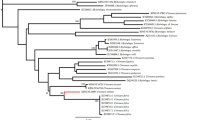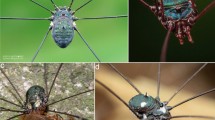Abstract
Based on an almost complete skeleton ofBuxolestespiscator n. sp. Pantolestids are recorded in the oil shale of Messel for the first time. The analysis of the skeletal morphology confirms the semiaquatic mode of living in this group. An obvious adaptation to swimming, however, can only be found in the differentiation of the tail. In the maw-content ofBuxolestes fish remains are detected.
Kurzfassung
Auf Grund eines annähernd vollständigen Skelettes können die Pantolestidae im Ölschiefer von Messel mitBuxolestes piscator n. sp. erstmals nachgewiesen werden. Die Analyse der Skelettmorphologie bestätigt die semiaquatische Lebensweise dieser Gruppe. Eine eindeutige Schwimmanpassung ist allerdings nur in der Ausbildung der Schwanzwurzel zu finden. Im Mageninhalt des Tieres befinden sich Fischreste.
Similar content being viewed by others
Literatur
Böker, H. (1935): Einführung in die vergleichende biologische Anatomie der Wirbeltiere. —228 S., Jena.
Butler, P. M. (1972): The problem of insectivore classification.—In:Joysey, K. A. &Kemp, T. S. (Eds.): Studies in Vertebrate Evolution:. Oliver & Boyde, Edinburgh.
Cray, P. E. (1973): Marsupialia, Insectivora, Primates, Creodonta from the Headon beds (Upper Eocene) of Southern England. — Bull. British Mus. (Natur. Hist.) Geol.23/1, 102 S., London.
Franzen, J. L. (1977): Die Entstehung der Fossillagerstätte Messel. — Ber. naturforsch. Ges. Freiburg i. B.67: 53–58, Freiburg i. B.
—— (1977): Urpferdchen und Krokodile. Messel vor 50 Millionen Jahren. — Kl Senckenberg-Reihe 7, 36 S., Frankfurt a. M.
Gervais, P. (1859): Zoologie et Paléontologie Francaise. — 544 S., 2. Ed., Paris (Bertrand).
Gregory, W. K. (1910): The orders of Mammals. —Bull. am. Mus. natur. Hist. 27: V+524 S., New York.
Heil, R.;Koenigswald, W. v. &Lippmann, H. G. (1979): Fossilien der Messeler Schichten. —88 S., Darmstadt (Hess. Landesmus.).
Heissig, K. (1977): Neues Material vonCryptopithecus (Mammalia, Pantolestidae) aus dem Mitteloligozän von »M6hren 13« in Mittelfranken. —Mitt. Bayer. Staatsslg. Paläont. hist. Geol.17: 213–225, München.
Helbing, H. (1921): Zur Skelettrekonstruktion eines oberoligozänen Fischotters. — Verh. Schweizer Naturforsch. Ges.101: 209–210, Aarau.
Hopwood, A. T. (1927):Dyspterna woodi, gen. et sp. n. a carnivore from the Oligocene, Isle of Wight. — Am. Mag. Natur. Hist.ser 9,20: 174–176, London.
Huxley, T. H. (1880): On the application on the laws of evolution to the arrangement of the Vertebrata and more particulary of the Mammalia. — Proc. zool. Soc. Lond.1880: 649–662, London.
Jaeger, J. J. (1970): Pantolestidae nouveaux (Mammalia, Insectivora) de ľEocène moyen de Bouxwiller (Alsace). — Palaeovertebrata3: 63–82, Montpellier.
Koenigswald, W. v. (1979): Ein Lemurenrest aus dem eozänen Ölschiefer der Grube Messel bei Darmstadt. — Palaont. Z.53: 63–76, Stuttgart.
—— (1980): Fossillagerstatte Messel — Literaturübersicht der Forschungsergebnisse aus den Jahren 1969-1979. — Geol. Jb. Heesen108: 23–37, Wiesbaden.
Kükenthal, W. (1890): Über die Anpassung von Säugethieren an das Leben im Wasser. — Zool. Jb., System.5: 373–399, Jena.
Lippmann, H. G. &Wiemer, G. (1979): Bergung und Präparation von Fossilien aus der Grube Messel unter Berücksichtigung eines Primatenfundes. — Der Präparator25: 3–13, Bochum.
Maier, W. (1979):Macrocranion tupaiodon, an adapisoricid(?) Insectivore from the Eocene of “Grube Messel” (Western Germany). — Paläont. Z.53 1/2: 38–62, Stuttgart.
Matthew, W. D. (1909): The carnivora and insectivora of the Bridger Basin, Middle Eocene. — Mem. Amer. Mus. Natur. Hist.9/4: 291–567, New York.
McKenna, M. (1975): Toward a phylogenetic classification of the Mammalia. —In:Luckett, W. P. &Szalay, F. S. (Eds.): Phylogeny of the primates, New York (Plenum Publisher).
Quinet, G. E. (1965): Un condylarthre de Hoogbutsel. — Inst. Roy. Scie. natur. Belgique, Bull.41/15, 5 S., Brüssel.
Russel, D. E. (1964): Les mammifères paléocènes ďEurope. —Mem. Mus. Natur. Hist. Natur. N. S. C 13, 324 S., Paris.
Savage, R. J. G. (1957): The anatomy ofPotamotherium an Oligocene Lutrine.— Proc. Zool. Soc. London129: 151–244, London.
Schlosser, M. (1887-1890): Die Affen, Lemuren, Chiropteren, Insektivoren etc. des europäischen Tertiärs und deren Beziehungen zu ihren lebenden und fossilen außereuropäischen Verwandten. — Beitr. Palaeont. Österr. Ung. Orients6: 1–224 und8: 1-106, Wien.
Simpson, G. G. (1937): The Fort Union of the Crazy Mountain field, Montana and its Mammalian Faunas. — U.S. Nat. Mus. Bull.169, 287 S., Washington.
Smith, J. D.;Richter, G. &Storch, G. (1979): Wie Fledermause sich einmal ernährt haben. —Umschau79/15: 282–284, Frankfurt.
Starck, D. (1979): Vergleichende Anatomie der Wirbeltiere auf evolutionsbiologischer Grundlage. Bd. 2. Das Skelettsystem. — 776 S., Berlin, Heidelberg, New York (Springer).
Storch, G. (1978): Ein Schuppentier aus der Grube Messel. —Zur Paläobiologie eines mitteleozänen Maniden. — Natur und Museum108: 301–307, Frankfurt a.M.
—— (1978):Eomanis waldi, ein Schuppentier aus dem Mittel-Eozän der #x00BB;Grube Messel« bei Darmstadt (Mammalia: Pholidota). — Senckenbergiana lethaea59: 503–529, Frankfurt a.M.
Sturm, M. (1978): Maw contents of an Eocene horse(Propalaeotherium) out of the oil shale of Messel near Darmstadt. — Cour. Forsch.—Inst. Senckenberg,30: 120–122, Frankfurt a.M.
Tedford, R. H. (1976): Relationship of pinnipeds to other carnivores (Mammalia). — System. Zool.25: 363–376, USA.
Tobien, H. (1957): Zur Paläontologie des mittel—eoz#x00E4;nen Ölschiefer-Vorkommens von Messel bei Darmstadt. — Z. dt. geol. Ges.109/2: 665–666, Hannover.
—— (1968): Das biostratigraphische Alter der mitteleozänen Fossilfundstätte Messel bei Darmstadt (Hessen). —Notizbl. Hess. L.-A. Bodenforsch.96: 111–119, Wiesbaden.
—— (1969): Die alttertiäre (mitteleozäne) Fossilfundstätte Messel bei Darmstadt (Hessen). — Mz. naturwiss. Archiv 8: 149–180, Mainz.
van Valen, L. (1967): New Paleocene Insectivores and Insectivore Classification. — Bull. Amer. Mus. of Natur. Hist.135, 284 S., New York.
Viret, J. (1929): Les faunes mammifères de ľOligocène supérieur de la Limagne Bourbonaise. — Ann. Univ. Lyon47, 328 S., Lyon.
Author information
Authors and Affiliations
Rights and permissions
About this article
Cite this article
Koenigswald, W.v. Das Skelett eines Pantolestiden (Proteutheria, Mamm.) aus dem mittleren Eozän von Messel bei Darmstadt. Paläont. Z. 54, 267–287 (1980). https://doi.org/10.1007/BF02988130
Received:
Issue Date:
DOI: https://doi.org/10.1007/BF02988130




